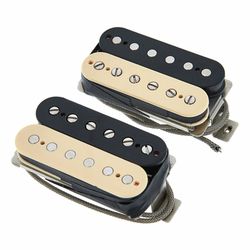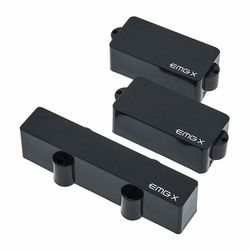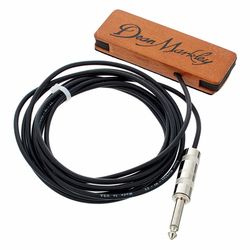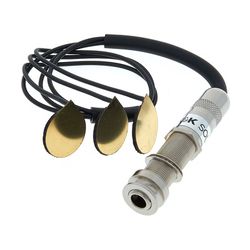What types of pickups are there?
Magnetic pickups
Electric guitars and electric basses almost always use magnetic pickups, which consist of a magnet and a coil. These pickups capture string vibrations and convert them into electric voltage. A pickup with just one coil is known as a single coil, while a pickup with two coils is known as a humbucker. Although technically a single coil pickup, the P-90 has a category of its own due to its shape.
Pickups in electric guitars and electric basses are screw-mounted to the guitar's body and connected to the electronics (switches, potentiometers, and jack) via a wiring harness. The pickups can be easily replaced, especially as their dimensions are largely standardised.
Magnetic pickups are also available for steel-string acoustic instruments such as acoustic guitars but are not compatible with classical guitars and ukuleles, which use nylon strings.
Piezo
Piezo pickups, consisting of a ceramic strip and typically installed in the bridge, convert mechanical pressure differences and structure-borne sound into electric voltage and work with all acoustic string instruments.
Many acoustic guitars, classical guitars, and ukuleles are already fitted with piezo pickups, which usually require active (battery-powered) preamps. These preamps, located in the side or soundhole of the guitar, often feature sound control and tuning facilities. Retrofitting these pickup systems typically requires specialist expertise.
Transducers
A transducer or contact pickup works like a piezo pickup but is more straightforward to retrofit. Typically comprising a self-adhesive contact surface and a jack, transducers can be applied anywhere on the instrument's surface. Also suitable for ukuleles, banjos, and mandolins, transducers are ideal for beginners exploring the world of acoustic sound capture and often do not require batteries.
Pickups for electric guitars
Electric guitar pickups are divided into three categories: humbuckers, single coil pickups, and P-90 pickups. Below is a brief overview of their main characteristics:
Single coils
- One coil
- Clear, bright sound
- Traditionally installed in T-style (e.g. Fender Telecaster) and ST-style (e.g. Fender Stratocaster) guitars
- Ideal for Pop, Funk, Blues, and clean or overdriven Rock sounds
- Prone to noise interference
Humbucker
- Two coils
- Warm, powerful sound
- Ideal for clean Jazz sounds and heavily distorted Hard Rock or Metal sounds
- Traditionally installed in single cut guitars (e.g. Gibson Les Paul), double cut guitars (e.g. Gibson SG), and heavy guitars
- Less prone to noise interference
P-90
- One coil
- Powerful single coil in a larger housing
- Dynamic sound, between a single coil and humbucker
- Traditionally installed in guitars like the Gibson Les Paul Junior
In addition to this broad classification, there are many subcategories of pickups for electric guitars, including humbuckers in single coil format, active pickups, and pickups for seven and eight-string guitars.
More detailed information can be found in the buyer's guide to pickups for electric guitars.
Pickups for acoustic guitars
Magnetic pickups, piezo pickups, transducers, or special microphones for acoustic guitars are recommended for amplifying acoustic instruments. Here is a brief overview:
Magnetic pickups
- Warm sound
- Easy to install (in the soundhole)
- Minimal transmission of body noise
- Not suitable for nylon strings
Piezo pickups
- Bright sound
- More difficult to install
- Typically requires an active preamp (with battery)
- Transmit solid-borne sound
- Work with all acoustic string instruments
Transducers
- Balanced sound pattern
- Easy to install
- Weak output level (without preamp)
- Flexible placement
- Work with all acoustic string instruments
Microphones for acoustic guitars
- Euthentic sound reproduction
- Ideal for recording
- Typically not permanently installed
- Prone to ambient noise and feedback
Many guitarists rely on a combination of different pickup systems, and some manufacturers offer ready-made combinations (such as microphone and piezo) in their products.
A detailed description of the characteristics and applications of these pickups can be found in the Buyer’s guide to pickups for acoustic guitars.







)
)